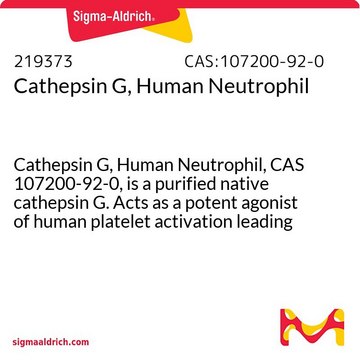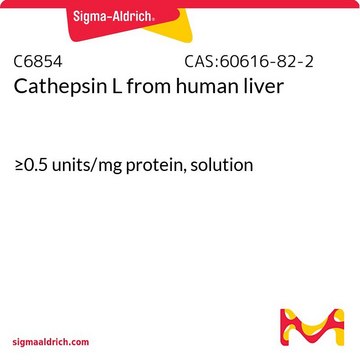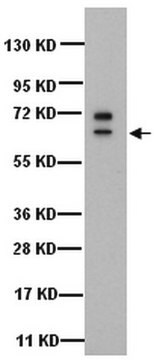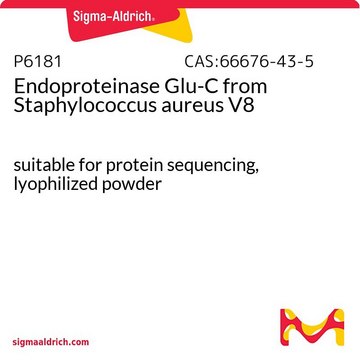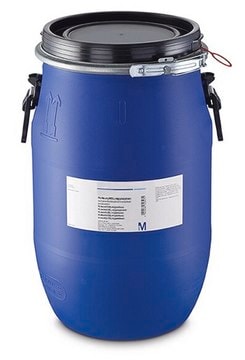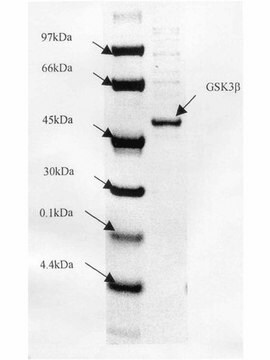219402
Cathepsin L, Human Liver
Cathepsin L, Human Liver, CAS 60616-82-2, is a native, the most potent of all the lysosomal proteinases. Plays a major role in the proteolysis of both cellular and endocytosed macromolecules.
동의어(들):
CTSL, CTSL1, Human Cathepsin L, Major excreted protein (MEP)
로그인조직 및 계약 가격 보기
모든 사진(1)
About This Item
추천 제품
생물학적 소스
human liver
Quality Level
설명
Merck USA index - 14, 1905
양식
liquid
제조업체/상표
Calbiochem®
저장 조건
OK to freeze
avoid repeated freeze/thaw cycles
기술
activity assay: suitable
적합성
suitable for molecular biology
응용 분야
life science and biopharma
배송 상태
wet ice
저장 온도
−70°C
유전자 정보
human ... CTSL(1514)
일반 설명
Research area: Cell Signaling
Cathepsin L, Human Liver, native, is the most potent of all the lysosomal proteinases. Cathepsin L (CTSL) belongs to the papain subfamily of cysteine proteases and is mainly located in endolysosomal vesicles.
Cathepsin L, Human Liver, native, is the most potent of all the lysosomal proteinases. Cathepsin L (CTSL) belongs to the papain subfamily of cysteine proteases and is mainly located in endolysosomal vesicles.
생화학적/생리학적 작용
Cathepsin L (CTSL) has higher activity than cathepsins B and H in the degradation of a variety of physiological protein substrates. It is believed to be responsible for the generation of endostatin from the NC1 domain in collagen XVII. It is responsible for regulating cell cycle, nucleotide-binding domain, leucine-rich–containing family, pyrin domain–containing-3 (NLRP3) inflammasome activation, proteolytic processing of Bid during apoptosis, and TGF-β signaling. It can degrade a wide range of proteins, encompassing enzymes, receptors, and transcription factors. Additionally, it produces active enzymes, receptors, and biologically active peptides through controlled proteolysis. Moreover, Cathepsin L has been observed to enhance tumor cell migration by lowering cell-cell adhesion and breaking down elements of the extracellular matrix. The expression of CTSL escalates in several types of cancers, including glioma, melanoma, pancreatic, prostate, and breast cancer. It plays a major role in the proteolysis of both cellular and endocytosed macromolecules.
포장
Please refer to vial label for lot-specific concentration.
경고
Toxicity: Standard Handling (A)
단위 정의
One unit is defined as the amount of enzyme that will hydrolyze 1.0 µmol of Z-FR-AFC per min at 25°C, pH 5.5.
물리적 형태
In 400 mM NaCl, 20 mM malonate buffer, 1 mM EDTA, pH 5.5.
제조 메모
Prepared from tissue of individuals that have been shown by certified tests to be negative for HBsAg and for antibodies to HIV and HCV.
재구성
Following initial thaw, aliquot and freeze (-70°C).
기타 정보
Note: 1 mU = 1 milliunit
법적 정보
CALBIOCHEM is a registered trademark of Merck KGaA, Darmstadt, Germany
Storage Class Code
12 - Non Combustible Liquids
WGK
WGK 2
시험 성적서(COA)
제품의 로트/배치 번호를 입력하여 시험 성적서(COA)을 검색하십시오. 로트 및 배치 번호는 제품 라벨에 있는 ‘로트’ 또는 ‘배치’라는 용어 뒤에서 찾을 수 있습니다.
자사의 과학자팀은 생명 과학, 재료 과학, 화학 합성, 크로마토그래피, 분석 및 기타 많은 영역을 포함한 모든 과학 분야에 경험이 있습니다..
고객지원팀으로 연락바랍니다.